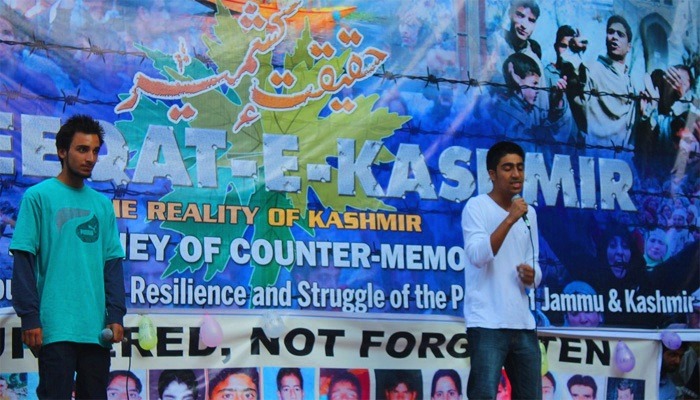In this post, Gowhar Farooq, one of the researchers who received the Social Media Research grant for 2014, introduces his proposed work.

Young rap artists ‘Kayemmar’ perform at ‘Haqeeqat-e-Kashmir’ (Reality of Kashmir), at Srinagar Muncipal Park in the Lal Chowk, Kashmir, on September 7, 2013. The event was held parallel to ‘Ehsaas-e-Kashmir’ (Feel of Kashmir) held at Shalimar Garden, Srinagar, where veteran musical conductor Zubin Mehta performed for invited guests. Source: Imaad Nazir.
Buoyed by successive years of visible clam and tourist influx, the government decided to hold Santosh Football Trophy in Jammu and Kashmir in June 2008 — with the second leg of the tourney in Srinagar. Except for the few moments, when the TV commentators had to describe posters that read ‘We Want Freedom’ or when police had to sternly warn people, and, sometimes briefly arrest them for raising ‘Azaadi’ (freedom) slogans in the stadium, or the June 8 protests — when a crowd burst into protests and invaded the ground — in a Punjab vs J&K match, the tournament, by and large, was a success.
Unfortunately in Kashmir, the lull has always been projected as ‘normalcy’ by the establishment. The need for the dialogue is only felt or statements like Narisima Rao’s ‘sky is the limit short of azaadi’ are only made in turmoil. Lull in the time to cash on!
Barely a few days after the tournament, when mainstream newspaper columnists and TV anchors were calculating the number of tourists that had visited the Valley in preceding years and projecting a record tourist arrival for year 2008, Kashmir erupted.
In the next three years, protests, stone-pelting, curfews, tear-gas-shelling, killings, processions, more killings, more curfew, arrests, torture and detentions became the norm. Like Rao, Manmohan Singh government in 2010 suddenly felt the need for reaching out to the Kashmiri youth. Then, as always, the lull followed!
The protests, which began in 2008, gave rise to the need for media through which the situation in Kashmir could pierce the mountains veiling Kashmir and reach the world. When media was gaged in Kashmir, Kashmiris became desperate to make their voices heard. However, much of the mainstream media in India – due to editorial policy, pressure from various quarters or collusion – failed to meet the aspirations of Kashmir. For Kashmiris, it was the time to look beyond the conventional. It was the time to look for the alternative.
When the Arab world was still reeling under autocratic rulers and ‘the Spring’ was far away, Kashmir had already seen two bloody summers. If the December 2010, Arab Spring was catapulted by social media, it was quite opposite in Kashmir. Citizens in Kashmir had to explore and experiment and micro-blogging was still not popular. Later, websites run by youngsters, most of whom where in colleges, begun surfacing in Kashmir by 2010. Thus, the ‘Spring’ had arrived in Kashmir much ahead of the Arab world. However, it did not get the international attention it deserved.
Pages on social networking sites and a few blogs began leading social change in Kashmir from June-July 2008. Almost two years later, people, mostly journalism students, started their own websites. The idea was to converge like-minded people and share news and ideas (narrative from Kashmiri’s perspective), which we thought were missing from mainstream media. There were no funds, no offices and most of owners were pooling money from their own pockets but almost three websites were running parallel(y) by the end of 2010. One group had a faint idea who the other two were. These pages and websites not only gave people a vent to share their political ideologies but steadily developed into forums of public debate and discussions, which by then were missing.
I aim to capture the causes that led to rise of the alternative (online) media in Kashmir, its evolution, impact (social and political) and significance through stories and conversations – and research – with people who gave birth to it, how they made it happen and their aims –– bound in a text-cum-picture book/ paper.
This will be done through research, analysis of the situation(s), personal involvement and elaborate interviews. Further, important events and cases (both individual and public) that involved/boosted the alternative media will be featured. The book/ paper will also have a series of images (portraits and a photo essay).
Also, two major uprising uprisings broke out immediately before and after the 2008 protests in Kashmir – the ‘saffron revolution’ (October 2007) in Burma and the Iranian revolution (late 2009). The protests in Kashmir erupted in between the two; however, they did not get the international attention as the other two. I will also to look into the reasons for this – political, economic and operational.
The saying, “In war, truth is the first casualty,” holds true to Kashmir also. There are multiple versions of a single event and there is no absolute truth. Also, being a disputed conflict zone, there is limited space for the freedom of speech and the freedom to express ideas. Thus the rise of alternative media is significant. Hence, it is important to reveal the story behind its rise and the story of people who gave birth to it and what they aim. It is important to put into perspective why these activists chose this path. Here, ‘Why they did’ is as important as ‘What they did’!